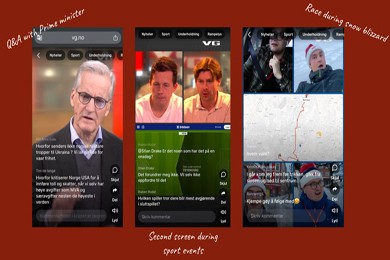Feeling that traditional video and live broadcasts were becoming outdated, Norwegian publisher Schibsted’s VG shifted to a vertical format and found a broader, younger audience.
In an INMA ideas blog, video product manager Kristin Nyland tells of the transition into ‘The Vertical Shift’.
“Covering breaking news in a TikTok-style vertical live video format might have seemed impossible for VG only a few years back, but today we’ve not only embraced this shift, we have also redefined how video is consumed and engaged with on our brand site,” she says.
“Our transition into ‘The Vertical Shift’ answered a significant challenge – traditional video and live broadcasts felt outdated. Younger viewers are addicted to social media, consuming short, interactive videos, while our linear TV-style broadcasts struggled to capture their attention.
“We needed to modernise our coverage to bridge this gap.”
Nyland says traditional news operates in “a one-way model”. Journalists present, audience listens.
“So, in an era where people expect real-time interaction, we were forced to rethink our approach.”
Key goals were to:
-make news mobile-first, utilising the vertical fullscreen mode without flipping the screen;
-increase video consumption and keep users watching multiple videos per session;
-explore seamless monetisation and introduce ads that didn’t disrupt the experience; and
-enable real-time engagement, allowing audiences to comment, react, and participate.

Building a scrollable vertical video player was an iterative process done in close collaboration with users, journalists and advertisers. “We sought to optimise technical performance, increase user engagement, and provide enough relevant content whilst continuing to make money to fund our journalistic mission.
“After performance issues were handled during the initial development, we realised that a new, well-performing format wasn’t enough: users expect interactivity and enough quality content in a non-intrusive experience. This became an important focus for us, and today, we have a product that delivers this and scales across all news outlets in Schibsted Media.”
These new features allow all of the following:
-users can easily swipe through short-form clips, live updates and breaking news;
-viewers engage with content live, fostering a two-way conversation and a sense of community;
-journalists hear back from their viewers and can adapt the news coverage accordingly.;
-editors curate playlists for major events, from breaking news to concerts; and
-adaptive ad formats based on users’ viewing patterns mix non-skip and skippable ads to balance revenue and user experience.
Nyland says the US election was a game-changer, “our first big live news event where our news coverage was presented vertically, adapted to the mobile screen.
“It also marked the launch of our live comment feature. Instead of a long, traditional news broadcast, we delivered a real-time, vertical, interactive experience in which viewers could:
-swipe through live updates;
-ask questions in real time; and
-engage directly with journalists.
“We reached 833,000 livestream viewers and had more than 3500 audience interactions. We were delighted to see the response amongst younger users, with more than half of all interactions coming from viewers under 35.”
The success of the election coverage proved that users were eager to interact when given the opportunity. It also provided a unique way of shaping the storytelling during live events.
“We now have the opportunity to create a fun, lighthearted dialogue with our audience live on the air and respond to the questions they are concerned about. Recent examples include sports coverage where VG doesn’t hold the livestream rights, the Trump inauguration, a race between journalists commuting in a snow blizzard in Oslo, and a Q&A session with the Norwegian prime minister.
“News isn’t just about delivering information – it’s about creating experiences. The vertical shift in VG has proven that video news can be dynamic, engaging, and interactive, and we’re excited to keep pushing the boundaries of digital storytelling.”















Comments